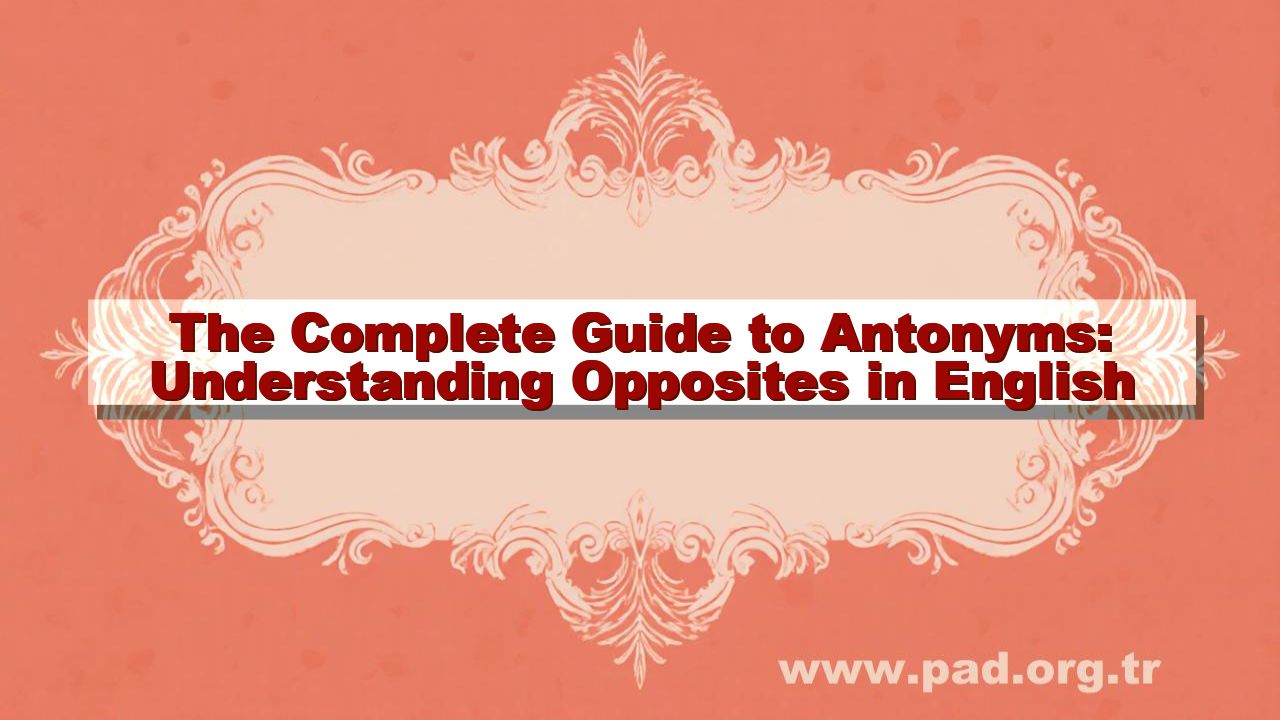I remember back in high school, I wrote a story where I kept using the word ‘great’ to describe everything—a great day, a great meal, a great joke. My teacher, bless her heart, handed it back with ‘Boring!’ scrawled across the top. She told me I needed contrast. That really hit me hard, and I started studying antonyms, realizing how they give words power by showing you the other side of the coin. It’s not just about knowing that ‘bad’ is the opposite of ‘good’; it’s about having the option to use ‘terrible,’ ‘atrocious,’ or ‘abysmal’ instead, to truly nail the feeling.
The Different Flavors of Opposite: Types of Antonyms You Need to Know
Antonyms aren’t just one simple thing. Like a good box of chocolates, they come in different types, and knowing the differences lets you use them with real precision. Ignoring these types is like trying to drive a car when you only know how to press the gas. You’ll go forward, sure, but you won’t be navigating any corners well. Due to the fact that language operates on spectrums and relationships, we break antonyms down into three main categories:
Complementary Antonyms: The Absolute Pairs
These are the pairs where there’s absolutely no middle ground. They are mutually exclusive. If one is true, the other one cannot be. Think of it like an on/off switch; it’s one or the other. You can’t be a little bit ‘on’ and a little bit ‘off’ simultaneously. This is the simplest kind of opposite, and it gives you definitive, powerful contrast. When you use words like alive/dead or true/false, you are dealing in absolutes, leaving no room for ambiguity. They are perfect for making definitive, undeniable claims.
Gradable Antonyms: The Sliding Scale
Now, this is where things get fun because most words in the English language fall here. Gradable antonyms are opposites that exist on a scale or a spectrum. Between ‘hot’ and ‘cold,’ you have ‘warm,’ ‘cool,’ ‘tepid,’ and ‘mild.’ You can also use intensifiers like ‘very’ or ‘a little bit’ with them. You can be ‘very happy’ or ‘a little bit sad.’ This type of opposite is essential for descriptive writing, as it lets you paint a much more detailed and nuanced picture. When you say something is big, you understand that something else can be small, but you also know there’s a world of ‘medium-sized’ in between.
Relational Antonyms: The Dependent Duo
These pairs show a relationship where one word cannot exist without the other; they define each other’s roles. You can’t have a teacher without a student, and you can’t be a parent without a child. They represent opposite sides of the same single transaction or structure. This kind of antonym is super important when you are discussing structures, roles, or interactions, because you inherently know the opposite side of the relationship is also being referenced. This means, Madem ki you use ‘buy,’ the idea of ‘sell’ is immediately present in the reader’s mind, making for dense, efficient communication.
The Power of Prefix: Creating Your Own Opposites
One of the quickest ways to build a complete guide to antonyms is to realize that you can often create a new antonym just by adding a prefix to the front of a word. We call these derivational antonyms. You just slap on a negative prefix like ‘un-,’ ‘in-,’ ‘dis-,’ or ‘non-,’ and bam—you’ve flipped the meaning. For example, turn happy into unhappy, visible into invisible, or agree into disagree. Due to the fact that English has borrowed from so many languages over the centuries, the specific prefix you need depends on the word’s origin, which is why sometimes it’s ‘il-‘ (like illegal) or ‘ir-‘ (like irregular); therefore, you can’t just pick one prefix and use it with everything, a point many non-native speakers often overlook but which is critical for sounding native. Learning this pattern is seriously a language shortcut, letting you double your active vocabulary without actually learning a whole new word.
Antonyms in the Age of AI: Trends & Vocabulary in 2025
Language never stops moving, and the world of opposite words is always getting new additions, especially now. What’s the latest? The trends of 2025 have added a bunch of new words, which, naturally, create new antonyms. You need to keep up with these if you want your language to sound fresh and relevant. The increasing focus on technology and culture gives us interesting new pairs. For example, as the trend of Quiet Luxury (understated, minimalist style) gains steam, its practical antonym becomes the older, flashy concept of Overt Display (big logos, excessive branding). Similarly, in the tech world, the clear antonym of AI Fluency (being good at using AI tools) is Digital Illiteracy (lacking basic tech skills), a key topic in 2025. This shows you that The Complete Guide to Antonyms isn’t a static book; it’s a living, breathing concept that changes weekly. You need to pay attention not just to the old classics but also to the words being born out of current cultural and tech shifts to keep your writing genuinely cutting-edge.
FAQ Schema: The Complete Guide to Antonyms
Are antonyms and opposite words the same thing?
Absolutely, they are the same concept! ‘Antonym’ is the technical, academic term for a word that has a contrasting or opposite meaning to another word. When someone says ‘opposite word,’ they mean ‘antonym.’ The key takeaway is that both terms refer to words like ‘hot’ and ‘cold’ or ‘up’ and ‘down,’ where the meanings clash completely or exist on opposite ends of a spectrum.
Why do people say antonyms are important for improving vocabulary?
Learning antonyms is basically a two-for-one deal for your brain. When you learn the meaning of one word, say ‘pessimistic,’ and then immediately learn its opposite, ‘optimistic,’ you haven’t just learned one new word; you’ve learned two related concepts and their clear distinction. This helps your brain file them both much better, making your vocabulary growth both faster and stronger. It’s all about contrasting ideas for better retention.
Can every word have an antonym?
Nope, not every word has a perfect antonym, and that’s totally normal. Most adjectives and adverbs (like fast/slow or up/down) and many verbs (like remember/forget) have clear opposites. However, things like nouns (e.g., pencil or desk) or proper names don’t really have an opposite. The concept of ‘oppositeness’ works best when you are describing a state, quality, action, or relationship, not an object itself.

